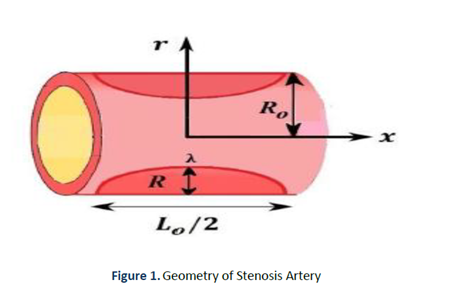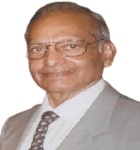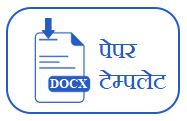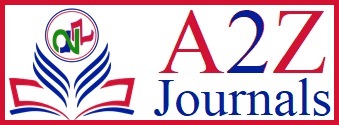Mathematical Modelling and Theoretical Exploration of Hybrid Blood-Nano-fluid Flow in a Stenosed Artery with Magnetization Effect

DOI:
https://doi.org/10.54060/a2zjournals.jase.111Keywords:
Mathematical model, impedance, nano- fluid, hybrid blood, shear stressAbstract
In this study, we investigate the effects of hybrid blood-nano-fluid flow in stenosis arteries under the influence of magnetization. The governing equations are expressed and solved using the standard finite difference method, and the key parameters, such as the flow parameter, Prandtl’s number, blood flow rate, and skin friction, are computed to detect the behavior of blood flow in stenosis arteries. The mathematical model uses blood as a Newtonian fluid and assumes that it is two-dimensional (2D).In order to give a thorough understanding of the physiological dynamics, the differences between these parameters are illustrated graphically. The results demonstrate that while a larger nano-particle volume fraction and Prandtl number result in a decrease in blood temperature, an increase in the flow parameter increases velocity. With the tailored use of nanoparticles, nanotechnology displays great promise from a biomedical perspective, especially in chemotherapy. For a more thorough and correct description of blood rheology, this study emphasizes the necessity for future modifications by adding more factors.
Downloads
References
Kumar and M. Jain, “Finite element Galerkin’s approach for a computational study of arterial flow,” Applied Mathematics and Mechanics, vol. 22, pp. 1012–1018, 2001.
A. Kumar, C. L. Varshney, and G. C. Sharma, “Computational technique for flow in blood vessels with porous effects,” Appl. Math. Mech., vol. 26, no. 1, pp. 63–72, 2005.
A. Ali and S. Das, “Electroosmotic influence on fractional Jeffrey blood flow with nanolay-er-coated tetra-hybrid nanoparticles in an electrified stenotic-aneurysm artery,” Computers in Biology and Medicine, vol. 88, no. 2025.
A. Ahmed and S. Nadeem, “Biomathematical study of time-dependent flow of a Carreaunanofluid through inclined catheterized arteries with overlapping stenosis,” J. Cent. South Univ, vol. 24, pp. 2725–2744, 2017.
A. Hussain, M. N. Riaz Dar, A. Rehman, F. Hussain, and N. Farooq, “Unconventional wall implications of intertwined stenosis in constrict artery,” Advances in Mechanical Engineering, vol. 15, no. 3, pp. 1–11, 2023.
A. Hussain, L. Sarwar, S. Akbar, and S. Nadeem, “Mathematical model for blood flow through the stenosed channel,” Phys. Scr., vol. 95, no. 2, p. 025206, 2020.
A. K. Gupta, “Finite element Galerkin’s scheme for flow in blood vessels with magnetic effects,” Int. J. Appl. Syst. Stud., vol. 2, no. 3, p. 284, 2009.
S. R. Shah, and R. Kumar, “Mathematical modeling of blood flow with the suspension of nanoparticles through a tapered artery with a blood clot”, Front. Nanotechnol, 2020.
J. Deshwal, S. Chaudhary, and R. Kumar, “Chemical reaction and inclined magnetic field effects on tri-hybrid Carreau nanofluid slip flow of blood past a porous inclined stenosed artery with viscous dissipation,” Phys. Scr., vol. 100, no. 3, p. 035216, 2025.
N. Abbas, S. Nadeem, and A. Saleem, “Computational analysis of water based Cu—Al2O3/H2O flow over a vertical wedge,” Adv. Mech. Eng, vol. 12, no. 11, pp. 1–10, 2020.
A. Ahmed and S. Nadeem, “Effects of magnetohydrodynamics and hybrid nanoparticles on a micropolar fluid with 6-types of stenosis,” Results Phys., vol. 7, pp. 4130–4139, 2017.
S. Nadeem, and S. Ijaz, “Theoretical analysis of metallic nanoparticles on blood flow through stenosed artery with permeable walls,” Phys. Lett. A, vol. 379, pp. 542–554, 2015.
S. S. Ardahaie, A. J. Amiri, A. Amouei, K. Hosseinzadeh, and D. D. Ganji, “Investigating the effect of adding nanoparticles to the blood flow in presence of magnetic field in a porous blood arterial,” Inform. Med. Unlocked, vol. 10, pp. 71–81, 2018.
A. Ali, S. Saleem, S. Mumraiz, A. Saleem, M. Awais, and D. N. Khan Marwat, “Investigation on TiO2–Cu/H2O hybrid nanofluid with slip conditions in MHD peristaltic flow of Jeffrey material,” J. Therm. Anal. Calorim., vol. 143, no. 3, pp. 1985–1996, 2021.
A. Ali, A. Noreen, S. Saleem, A. F. Aljohani, and M. Awais, “Heat transfer analysis of Cu–Al2O3 hybrid nanofluid with heat flux and viscous dissipation,” J. Therm. Anal. Calorim., vol. 143, no. 3, pp. 2367–2377, 2021.
N. S. Elgazery, “Flow of non-Newtonian magneto-fluid with gold and alumina nanoparticles through a non-Darcian porous medium,” J. Egyptian Math. Soc., vol. 27, no. 1, 2019.
A. Ahmed and S. Nadeem, “The study of (Cu, TiO2, Al2O3) nanoparticles as antimicrobials of blood flow through diseased arteries,” J. Mol. Liq., vol. 216, pp. 615–623, 2016.
K. S. Mekheimer, W. M. Hasona, R. E. Abo-Elkhair, and A. Z. Zaher, “Peristaltic blood flow with gold na-noparticles as a third grade nanofluid in catheter: Application of cancer therapy,” Phys. Lett. A, vol. 382, pp. 85–93, 2018.
D. G. Yakubu, M. Abdulhameed, G. T. Adamu, and A. M. Kwami, “A study of fractional relaxation time derivative on blood flow in arteries with magnetic and thermal radiation effects,” Diffus. Found., vol. 26, pp. 126–144, 2020.
J. Prakash and O. D. Makinde, “Radiative heat transfer to blood flow through a stenotic artery in the presence of magnetic field,” Latin American Applied Research, vol. 41, pp. 273–277, 2011.
A. S. Dawood, F. A. Kroush, and R. M. Abumandour, “Multi-effect analysis of nanofluid flow in stenosed arteries with variable pressure gradient: analytical study,” SN Applied Sciences, vol. 5, p. 382, 2023. https://doi.org/10.1007/s42452-023-05567-6

Downloads
Published
How to Cite
CITATION COUNT
Issue
Section
License
Copyright (c) 2025 Anil Kumar, Ram Bharat Singh, Jyoti Sinha, Akash

This work is licensed under a Creative Commons Attribution 4.0 International License.



























